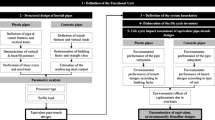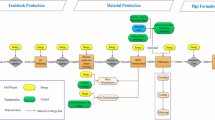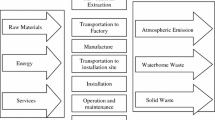Abstract
Purpose
The objective was to provide comprehensive life cycle inventories for the construction and renovation of sewers. A detailed inventory was provided with multiple options of pipe materials, diameters and site-specific characteristics, and was embedded into the Excel®-based tool SewerLCA. The tool allows for life cycle evaluation of different sewers. It was applied to determine the most important phases, processes, and related parameters involved in the construction and renovation of sewers from an environmental and economical perspective.
Methods
Comprehensive life cycle inventories (LCIs) for sewers construction and renovation were obtained by first identifying all processes involved after interviewing construction experts and reviewing sewer construction budgets from a Catalan company; and second transforming the processes into masses of materials and energy usage using construction databases. In order to run the life cycle impact assessment (LCIA) the materials and energy typologies from the inventories were matched to their corresponding equivalents into available LCI databases. Afterwards the potential impacts were calculated through the use of LCIA characterization factors from ReCiPe. Life cycle assessment (LCA) was run several times to assess the construction of a 1-km-long sewer with varying pipe materials, life spans for each material, diameters, transport distances, site-specific characteristics, and pipe deposition options.
Results and discussion
The environmental impacts generated by construction and renovation of a 1 km Polyvinylchloride (PVC) pipe with a diameter of 40 cm are mainly associated with pipe laying and backfilling of the trench. The evaluation of several pipe materials and diameters shows that the exclusion of renovation would underestimate the impacts by 38 to 82 % depending on the pipe materials and diameters. Including end-of-life phase for plastic pipe materials increases climate change (up to an extra 71 %) and human toxicity (up to an extra 147 %) impacts (among all diameters). The preferred pipe materials from an environmental point of view are precast concrete and High-Density Polyethylene (HDPE). Site-specific characteristics (specially the presence of rocky soil and asphalt placement) and material life span have a high influence on the overall environmental profile, whereas changes in transport distances have only a minor impact (<4 %).
Conclusions
Environmental impacts during the construction and renovation of sewers are subject to differences in material type, site-specific characteristics and material life span. Renovation of sewers has a large influence on all potential environmental impacts and costs and, hence, should not be omitted in LCA studies. The treatment and disposal processes of plastic pipes at the end of their life has to be accounted in LCA studies.










Similar content being viewed by others
References
Adequa Grupo Uralita (2007) Instalación de tuberías para abastecimiento, riego y saneamiento según normativa vigente. Madrid, Spain
Banc BEDEC (Structured data bank of building elements) http://itec.cat/nouBedec.c/bedec.aspx (Summer 2013)
Blosser M, Dobey E, Haub A, Iwai R, Mc Gowan V, Ring-Erickson L, Wise S (2003) Storm and Surface Water Plan—City of Olympia. http://olympiawa.gov/city-utilities/storm-and-surface-water/policies-and-regulations/policies-and-regulations-storm-and-surface-water-plan
Du F, Woods GJ, Kang D, Lansey KE, Arnold RG (2013) Life cycle analysis for water and wastewater pipe materials. J Environ Eng 139:703–711
European Environment Agency (2013) Urban waste water treatment—Indicator Assessment—data and maps—(p. 19). Copenhagen. http://www.eea.europa.eu/data-and-maps/indicators/urban-waste-water-treatment/urban-waste-water-treatment-assessment-3
Frischknecht R, Jungbluth N, Althaus H, Doka G, Dones R, Heck T, Hellweg S, Hischer R, Nemecek T, Rebitzer G, Spielmann M (2005) The ecoinvent Database: Overview and Methodological Framework. Int J Life Cycle Assess 10(1):3–9
Goedkoop M, Heijungs R, Huijbregts M, De Schryver A, Struijs J, Van Zelm R (2013) ReCiPe 2008—a life cycle impact assessment method which comprises harmonised category indicators at the midpoint and the endpoint level. http://www.lcia-recipe.net/file-cabinet
ISO 14040 (2006) Environmental Management - Life Cycle Assessment – Principles and Framework: International Standard 14040. International Standards Organisation, Geneva
ISO 14044 (2006) Environmental management—life cycle assessment—requirements and guidelines. International Standards Organisation, Geneva
Loubet P, Roux P, Loiseau E, Bellon-Maurel V (2014) Life cycle assessments of urban water systems: a comparative analysis of selected peer-reviewed literature. Water Res 67:187–202
Murray A, Horvath A, Nelson KL (2008) Hybrid life-cycle environmental and cost inventory of sewage sludge treatment and end-use scenarios: a case study from China. Environ Sci Technol 42:3163–3169
Noori M, Kucukvar M, Tatari O (2015) A macro-level decision analysis of wind power as a solution for sustainable energy in the USA. Int J Sustainable Energy 34(10):629–644
Petit-Boix A, Sanjuan-Delmás D, Gasol CM, Villalba G, Suárez-Ojeda ME, Gabarrell X, Josa A, Rieradevall J (2014) Environmental assessment of sewer construction in small to medium sized cities using life cycle assessment. Water Resour Manag 28:979–997
Piratla KR, Ariaratnam ST, Cohen A (2012) Estimation of CO2 emissions from the Life Cycle of a Potable Water Pipeline Project. J Manag Eng 28:22–30
Risch E, Gutierrez O, Roux P, Boutin C, Corominas L (2015) Life cycle assessment of urban wastewater systems: quantifying the relative contribution of sewer systems. Water Res 77:35–48
Udo de Haes HA, Heijungs R, Sangwon S, Huppes G (2004) Three strategies to overcome the limitations of life-cycle assessment. J Ind Ecol 8(3):19–32
Weidema BP, Bauer Ch, Hischier R, Mutel Ch, Nemecek T, Reinhard J, Vadenbo CO, Wernet G (2013) The ecoinvent database: overview and methodology, data quality guideline for the ecoinvent database version 3. www.ecoinvent.org
Acknowledgments
The authors would like to thank Voltes S.L.U. for the technical support, Ivet Domènech and Neus Jornada for the drawings in Fig. 1, Banc BEDEC, the Ramon and Cajal grant from Lluís Corominas (RYC-2013-14595), the Marie Curie Career Integration Grant PCIG9-GA-2011-293535 and the REaCH project (CTM2015-66892-R). Serni Morera’s FI scholarship (2015FI_B2 00071), STSMscholarship from EU-Cost Action Water2020 (ECOST-STSM-ES1202-110614-044095). LEQUIA and ICRA were recognized as consolidated research groups by the Catalan Government with codes 2014-SGR-1168 and 2014-SGR-291, respectively.
Author information
Authors and Affiliations
Corresponding author
Additional information
Responsible editor: Omer Tatari
Rights and permissions
About this article
Cite this article
Morera, S., Remy, C., Comas, J. et al. Life cycle assessment of construction and renovation of sewer systems using a detailed inventory tool. Int J Life Cycle Assess 21, 1121–1133 (2016). https://doi.org/10.1007/s11367-016-1078-9
Received:
Accepted:
Published:
Issue Date:
DOI: https://doi.org/10.1007/s11367-016-1078-9




